By now we’re all back into the language class swing, right? I love my breaks and I love teaching and I confess I have a love-hate relationship with that first day back after a break. I almost always have at least one dream sometime in the few days beforehand with one of the following scenarios:
- I can’t get out of the house. I run around but can’t get breakfast made, can’t get my hair fixed, can’t get my bags together, and suddenly it’s 1pm in the afternoon and I think, the kids are almost out of school and I’m still heating my hair straightener.
- I get to school and stand in front of a class full of expectant faces with… nothing. I look at my podium and the book is blank, the papers are blank, the POST-IT NOTES ARE BLANK. I’ve got no plans and no ideas.
Either way, I’m sunk. (No joke, I’ve started a new class this week and I had these dreams all weekend.)
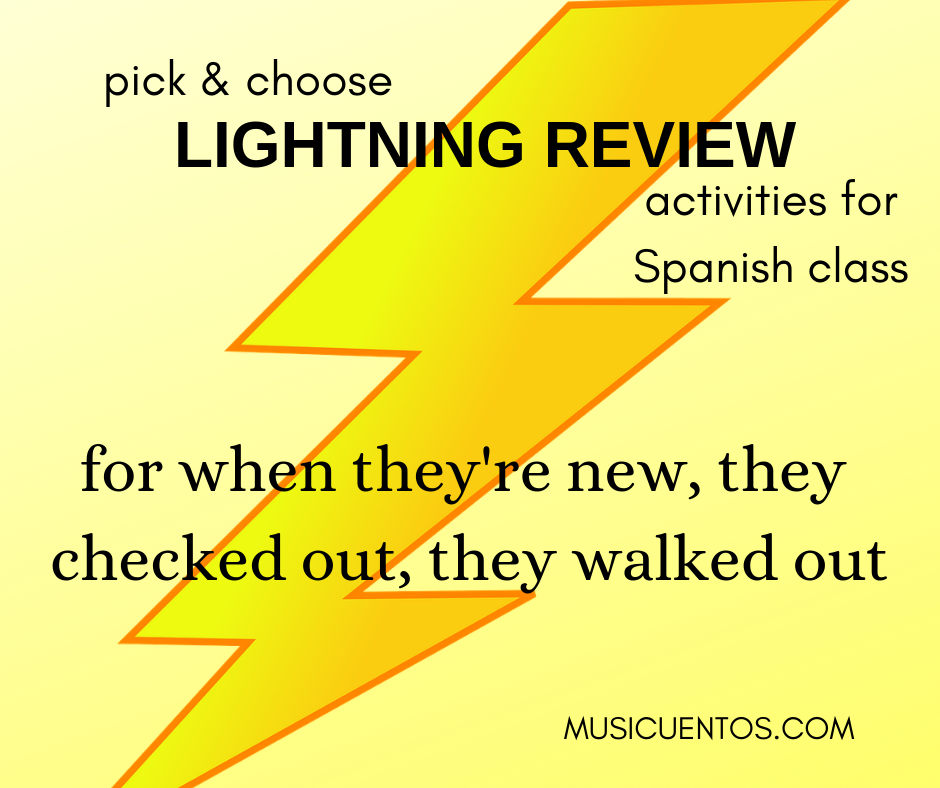
In honor of a back-to-classes lesson plan that worked exceptionally well for my learners, I want to share with you a series of activities that got us back into the swing of things. It happened without either blank faces or me getting reprimanded, and that’s a win. I had quite the odd situation where I had a significant percentage of new students in my two classes, and the rest I’d had before. What then? But we often face these surprise circumstances, right?
A third of the class just got called down for picture re-takes.
Yesterday it felt like half the class had just checked out – and the other half actually were out, with the flu.
Snowpocalypse surprised… no one.
For those days, perhaps you can have these ideas tucked in a file to pull out one or two or three (or all six) and keep the learning going. These are arranged to fit in one 90-minute lesson plan with two learning cycles of about 45 minutes each.
This example class was headed into a unit on recommending places to visit in our city. The unit involved a lot of work with description and activity verbs, talking about what I like and what I want, a lot of skills I wanted to review but avoid re-teaching if I could. This set of review activities in our learning cycles touched all the bases.
Cycle 1
Part One: Bracketing for Input
Shout out to Elisabeth at Spanish Mama for inspiration on this one. Given that learners are at their highest brain activity at the beginning of the lesson, that’s prime time for comprehensible input. A bracket sort is a perfect way to personalize learning and engage kids in input that’s easily tailored to whatever topic you’re targeting. You can see her picture and full explanation in that post under “5. The Cognates Game II” but basically, it’s like doing a March Madness bracket but asking students to vote on something. In my case, we used our activity verbs. You can easily change this to fit your upcoming theme, though. (Note that Elisabeth used it with cognates.)
- What food do you love?
- What activities do you love?
- Which animals are the most awesome?
As learners vote, you narrow the list to find a winner. My favorite thing about this is that it gets learners involved because they love to share their own opinions, but they don’t have to actually provide any TL output here – just raising a hand will do.
Part Two: Stations
In the second part of our first cycle, we’re still heavily focused on input, but with some more engagement and interaction required. This cycle it was time for stations. (An important key for me was to partner new students with former students on this.)
-
- Station 1: Activities opinion sort
Again, you can use just about any theme, but I used paper strips with the same activities from the bracket, and asked learners at this station to categorize them under opinion headings (e.g. “horrible” “amazing” “meh”). If you’re in a hurry, jotting them down on sticky notes will do.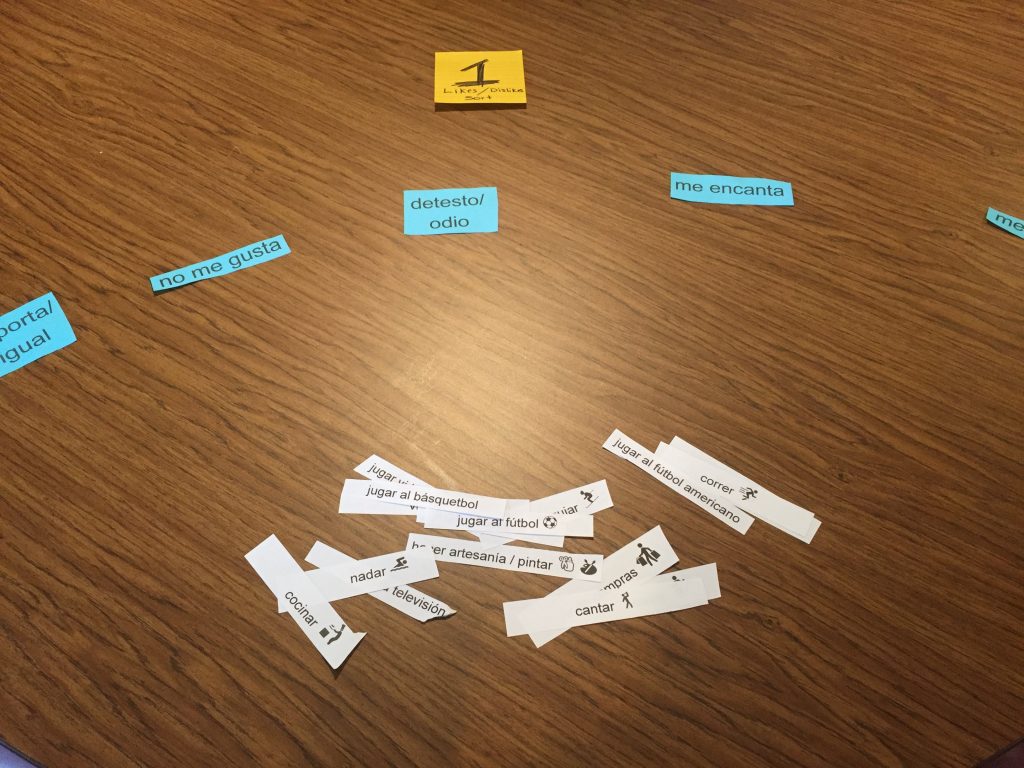
- Station 2: Vocab sort
I think I got this from a tweet and I apologize for not knowing who exactly shared the idea. I gave students cut-up papers with basic vocabulary we had done before and asked them to sort them into categories for this station. Again, if you don’t have prep time, sticky notes!
Ideas: Which words are places? Which words describe our school? Which words are foods? Which activities can be done in the winter?
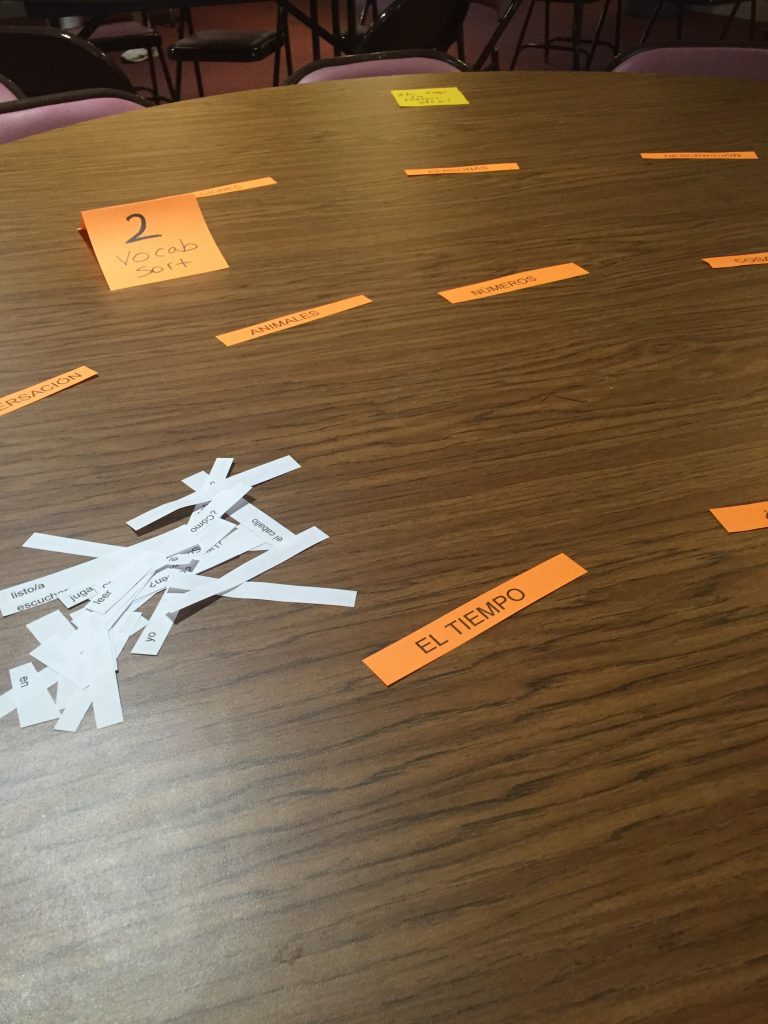
- Station 1: Activities opinion sort
- Station 3: Description slides
This was a pure output station. Students scrolled through images on slides on an iPad and described the pictures to a partner using all the words they could. For scaffolding, I pinned a set of comprehensible adjectives nearby.
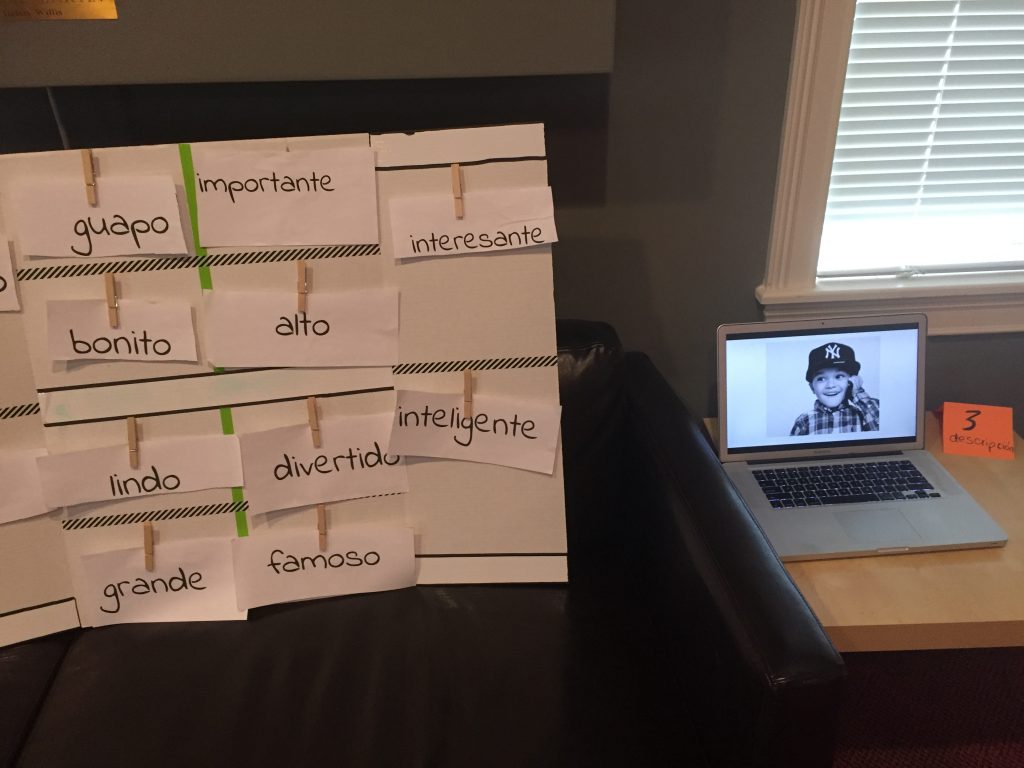
Okay, let’s take a brain break (how about Codo Rojo – we love that one!) and move to Learning Cycle 2.
Cycle 2
Part One: Game for Input
Again, we’re back to higher brain activity and need some input. The input for this cycle is the White Elephant game from Justin. (Yankee Swap? Dirty Santa? What do you call it?) Now, I knew I was going to do this beforehand so I told the students to bring a small, treasured possession. Instant student buy-in – they cared a whole lot about whether or not someone else was going home with their gaming device. Justin gives a lot of TL examples; in my class, we were focused on “wants” and “has,” specifically the switch from “(s)he wants/has” to “I want/have.”
If you don’t have kids bring in a treasured possession, you can do it like Justin and use a bin of random toys/stuffies/objects.
Part Two: Stations
- Station 1: “On an island” brainstorm twist
This is another idea from Elisabeth’s post. You can see some details under #7, “If you were on a deserted island…“. Since some of my learners knew very little, I had an iPad here with WordReference open so they could look items up. It’s also a good idea to give a list of cognates. To make this more station-friendly, you can eliminate the guessing aspect, and you can change up the question in many ways to fit your context, level, theme, etc.:
– 3 things you must pack to take to Costa Rica
– 3 favorite creatures that live in the ocean
– 3 things you’d find at a Day of the Dead celebration
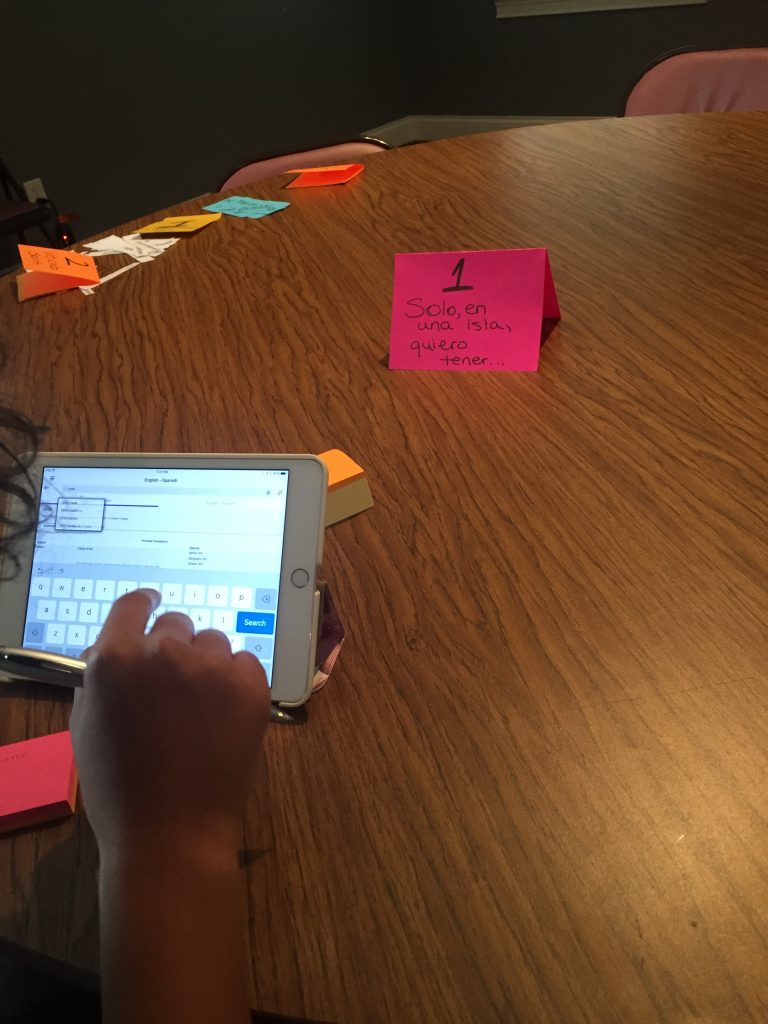
- Station 2: Saludos
Here, I just wanted students to tell each other something about themselves and how they were doing. I put tent cards with “Soy…” and “Estoy…” together with sheets/posters of options for how to complete these phrases.
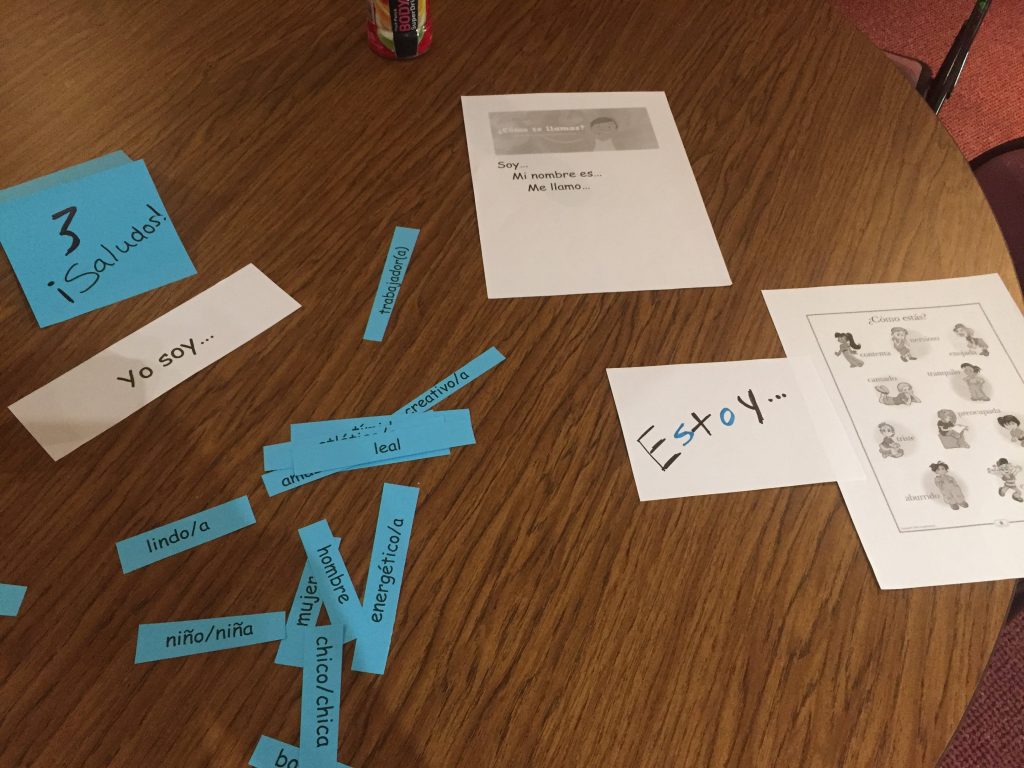
- Station 3: Ni tengo ni quiero vocabulary activity
This is another way to interact with nouns as input. Repetitions! And an actual task, because you’re using real language to for a real purpose – what do you want, or have, or both, or neither? A bonus here with the noun use is that you can just steal the nouns from the first cycle’s vocab sort activity (or use whatever nouns your learners need for the current unit/theme/project). At this station, learners manipulate words (if they know more words) or images (if their noun vocabulary is low) for:
(I) want
(I) have
and
neither
nor
with nouns to help them tell a partner (or group) what they have (a cat), want (a new car), have and want (coffee), or neither have nor want (a snake).

As I mentioned, this was for a long block class at the beginning of a semester with a strange mix of new/former students (and a teacher without quite all of her ducks in a row yet), but I hope you can see how you could pull one or two ideas out to spice things up on one of those weird days right around the corner for you!
 If Musicuentos has significantly helped you in your language teaching journey, consider becoming part of the “thanks” crew on Patreon. “La lotería” patrons receive every resource I produce, whether it’s a $2 activity or a $50 ebook guide, as thanks for their sponsorship.
If Musicuentos has significantly helped you in your language teaching journey, consider becoming part of the “thanks” crew on Patreon. “La lotería” patrons receive every resource I produce, whether it’s a $2 activity or a $50 ebook guide, as thanks for their sponsorship.
3 Comments
Comments are closed.
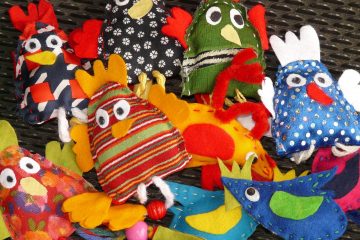



[…] am going to try the bracketing for input idea that I read on Sara-Elizabeth’s blog! I will put up a bracket of popular foods: […]
[…] of which fast foods we like the most. I find myself going back again and again to the idea of bracketing for input. It is quick, simple, engaging and zero […]
[…] idea came to me from Elisabeth over at Spanish Mama. I wrote about it recently in my lightning review post, so I won’t spend too much time on it here. It’s a fantastic, zero-prep, […]